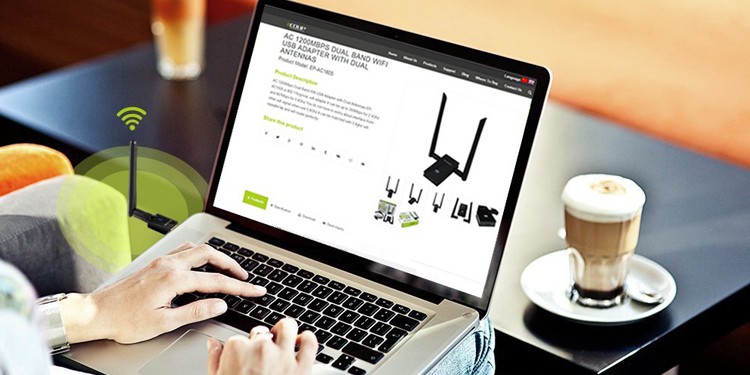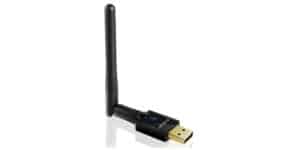Best USB Wi-Fi Adapters For 2024

Table of Contents
Here’s our guide to help you find the best USB WiFi adapters for you. Whether you want an extra boost to your laptop’s pre-existing Wi-Fi capabilities, or you want a powerful WiFi antenna for your desktop PC, we have you covered. We’ve picked out a bunch of different USB Wifi adapters, with varying features, and at a range of different prices.
If you have trouble understanding any of the jargon or specs mentioned, we’ve included a buying guide below to help you choose the right USB WiFi adapter for you.
Products at a Glance
How we tested the best USB WiFi adapters
We’ve compared the different adapters available today, focussing on those that have solid performance at a reasonable price. Each of these wi-fi adapters will offer a reliable wi-fi connection to supported devices and are competitively priced.
We’ve analyzed the specification and performance of each wi-fi adapter we’ve featured, and compared it with the available alternatives, picking out the models which offer the fastest and most reliable wireless connections, at the best prices.
Things to consider
If you’re going to be gaming with this USB wifi adaptor, we highly recommend opting for one of the USB 3.0 adaptors we’ve listed, since you’ve benefited significantly from the reduced latency.
Product Reviews
- Fast speeds
- MIMO support
- USB 3.0 support
- Size and shape not ideal for laptops
- Not the cheapest option
- Plain looking
The Linksys Dual-Band AC1200 Adapter is one of the most popular WiFi adapters on the market, and for good reason.
Don’t let the lack of a discrete antenna fool you: this baby is fast. Unlike many other small form factors (SFF) Wi-Fi adapters, this adapter comes packed with MU-MIMO support. This allows it to achieve faster download and upload speeds, so long as the router, it’s connected to also supports MU-MIMO technology.
In addition to the MIMO support, you also have the expected features intact here. That means USB 3.0 for lower latency and full 802.11ac network support. As always, we recommend using 5 GHz whenever available, especially for gaming purposes.
- USB 3.0 support
- Great speeds and range
- MIMO support
- A little pricey
- Awkward form factor for desktop PCs (without stand)
- Large size may put strain on USB ports
Some wi-fi adaptors look like something out of a sci-fi movie, and this is one such adaptor. It’s made up of two large black angular rectangles with a USB 3.0 jack sticking out at the end.
These two giant black rectangles can also be called the Netgear Nighthawk Wi-Fi adapter, but don’t let that weird design fool you: this is actually a very powerful option. The second black rectangle is actually a MIMO-powered 3×4 antenna array. This allows for superb range, download speeds, and latency– better than any of the USB WiFi adapters that we’ve listed so far.
It even has a docking station, which helps alleviate its strange design decisions for desktop use!
The only real issue with the Nighthawk is that it’s starting to get just a little expensive for a Wi-Fi adapter. At around $80 it’s towards the top end of what you can spend on a device like this. That’s a lot to ask for a Wi-Fi adapter, we think. Although it is a very reliable and great-performing adaptor.
- Reasonably compact
- Discrete antenna
- Great value
- Only supports USB 2.0
- Basic connectivity
- Not from a very well known brand
The EDUP Wi-Fi Adapter is the best cheap USB WiFi adapter we could find. While it may not support USB 3.0, it’s about as cheap as WiFi adapters get and it has the added boon of a discrete antenna.
The addition of a discrete antenna means that this adapter should enjoy fairly strong signal quality, especially if the antenna is pointed in the right direction. This does make the unit a bit larger and more inconvenient than a mini USB WiFi adapter, though.
If all you need is a Wi-Fi connection, a respectable range, and decent download speeds this has you covered. We wouldn’t recommend it for gaming, though.
- Low price
- Tiny size
- Simple design
- Only USB 2.0
- No discrete antenna will limit range
- Not from a very well known brand
The OURLiNK Wi-Fi dongle is a mini USB Wi-Fi dongle that boasts full support for 5 GHz Wi-Fi and 802.11ac. While this small form factor is ideal for those who want to keep their antennas hidden, this will result in reduced speeds if you aren’t close to your router.
This is very much an entry-level Wi-Fi solution: something to be used in small apartments and dorm rooms, not in large homes or through walls.
If all you need is the ability to connect to Wi-Fi (and you aren’t picky about things like latency or high download speeds), this will do the job and look good doing it. If you want low latency and high speed, though, we recommend one of the other options from this lineup of the best USB WiFi adapters.
- Excellent range
- Great speeds
- USB 3.0 support
- Unwieldy size
- High price
- No MIMO support
Let’s say you want a USB WiFi adapter, and you live in a big house. You’ve tried other solutions, but you’re always out of range and dealing with dropped connections. What do you do?
You get this bad boy, of course. The TRENDnet AC1900 USB Wireless Adapter doesn’t even look like a wireless adapter. With a whopping array of 4 antennas, it looks more like a miniature router in its own right.
Fortunately, those extra antennas translate to exactly what you’d expect: improved performance and range, especially when compared to cheaper options. In fact, we’re pretty sure that this has the best range out of any WiFi adapter available on the market, thanks to that quad-antenna design.
The lack of MIMO support may result in some lost speed, but if the range is your priority this is probably one of the best USB WiFi adapters for you.
Buying The Best USB WiFi Adapter For You
What’s the difference between 2.4 GHz and 5 GHz?
2.4 GHz and 5 GHz don’t refer to processing power in this context. Instead, they refer to the wireless network spectrum that Wi-Fi devices operate on.
2.4 GHz is the older standard and is what most routers and devices are still using. 2.4 GHz is somewhat slow and laggy when compared to 5 GHz, but it has a much greater range and compatibility.
5 GHz is the newer standard and is mainly used by newer devices. It’s much faster and has lower latency than 2.4 GHz, but has a much shorter range. You may also experience compatibility issues with older devices that are only made to connect to 2.4 GHz. To get around this, most routers and Wi-Fi antennas support both standards.
Even if all devices involved support both standards, use 5 GHz where possible. This is especially important for gamers since the lower latency of the 5 GHz standard will ensure less lag when playing online. 2.4 GHz generally isn’t suitable for gaming purposes but can suffice for web browsing and media consumption.
Important to note: no Wi-Fi connection will ever beat a hardwired ethernet connection when it comes to stability, latency, and overall performance. If you’re doing professional work or pro gaming, we recommend an ethernet cable whenever possible.
USB 2.0 vs USB 3.0
In terms of raw download speeds, you typically won’t see a massive difference between a USB 2.0 and USB 3.0 adapter. The max throughput of USB 2.0 is considerably higher than that of the average Wi-Fi connection, and USB 3.0 even more so. However, that doesn’t mean you shouldn’t get a 3.0 adapter whenever possible.
First and foremost, a 3.0 adapter will be able to keep up with particularly high-performance Wi-Fi networks. Particularly, connection speeds of over 100 Mbps, with routers using 802.11ac and broadcasting at 5 GHz.
But more importantly– even for slower networks– latency. USB 3.0 has much lower latency than USB 2.0, and latency is especially important for gaming. High latency results in a laggier, less responsive online gaming experience. Using Wi-Fi at all already increases latency, but using a USB 2.0 adapter on top of that can result in an unplayable experience for gamers.
If you’re going to game on Wi-Fi, a USB 3.0 adapter is a necessity, not an option.
Antennas, and why more is better
Wi-Fi is a wireless signal.
We aren’t going to dive into the nitty-gritty of wireless networks and how they work, but every wireless device has a built-in antenna, even if it isn’t visually obvious. Your smartphone, for instance, has an antenna; you just can’t see it.
Unfortunately, these invisible antennas do come with some sacrifices. While it’s nice to have an antenna be so small you don’t even know it’s there, this results in reduced reception and performance in most scenarios.
For high-performance Wi-Fi, you want an adapter with large, discrete antennas. This will allow the fastest speeds, lowest latency, and longest ranges to be achieved.
Our Verdict
We’ve picked the Linksys adaptor as our top choice from this roundup. It’s a good balance between functionality and price, it’s from a very reliable manufacturer that’s been making some of the best USB wifi adapters for many years, and it offers great speeds and stable connectivity.




